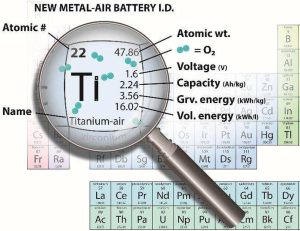Electricity from Air
Researchers from Forschungszentrum Jülich and Technion test novel titanium-air battery
Scientists at Forschungszentrum Jülich have developed and successfully lab-tested a novel titanium-air battery in cooperation with researchers at the Technion – Israel Institute of Technology in Haifa. This is the first time that experimental results of such a battery have been published, in which titanium is used as an active material. The metal is of interest as an electricity storage material because each atom can donate up to four electrons for charge transfer, while at the same time being relatively light and extremely resistant.
Scientific Results
Titanium is known as a passive, stable material. The researchers succeeded in utilizing its electrochemical potential for the storage of electrical energy by applying an ionic liquid called EMIm(HF)2.3F. Ionic liquids consist of salts with an atypical, very low melting point, which are used in a variety of applications due to their special electrical and material properties.
Titanium-air batteries theoretically have two to three times the energy density of zinc-air batteries, which are used today as standard button cells in hearing aids, control modules, and sensors. The theoretically achievable voltage of the titanium-air-battery is in a similar range to that of zinc-air batteries. In experiments, an average cell voltage of up to 1.2 volts and relatively high discharge currents of up to 0.75 mA cm-2 could be measured.
Social and Scientific Relevance
In metal-air batteries, the contained metal reacts with the oxygen in the air to release electrical energy. This type of battery thus occupies a special position among batteries, since one of the two reaction partners, oxygen, is obtained from the ambient air via a special electrode and does not have to be kept in the battery. Therefore, significantly higher energy densities can be realized with these systems than with common battery types, at least in theory.
For this reason, metal-air batteries are particularly suitable for applications where a compact size is important. Another potential area of application is in large-scale stationary storage systems that use low-cost, common, and non-toxic materials. For example, titanium, although known as an expensive material, is much cheaper than lithium in terms of material costs but is more expensive than aluminium. Titanium is the ninth most frequently occurring materials in the earth’s crust, so the available resources are correspondingly abundant.

Graphic illustration of titanium-air battery properties, in the style of the periodic table of elements
Further Details
Zinc, aluminium and iron for metal-air batteries, and silicon for silicon air batteries, are the main focus of research in anode materials today. Titanium, on the other hand, has hitherto hardly been considered as an active material, and experimental results had not yet been available.
The development of the new battery concept was carried out in close cooperation between Dr. Yasin Emre Durmus from the Jülich Institute for Energy and Climate Research (IEK-9) headed by Professor Rüdiger-A. Eichel and Professor Yair Ein-Eli from the Technion, who spent a seven-month-long sabbatical at IEK-9 as part of the Umbrella Cooperation between Forschungszentrum Jülich, the Technion, and RWTH Aachen University.
Original Publication
Yasin Emre Durmus, Marcel Kaltenberg, Krzysztof Dzieciol, Maximilian Schalenbach, Danny Gelman, Boris Shvartsev, Hermann Tempel, Hans Kungl, Rüdiger-A. Eichel, Yair Ein-Eli
Breaking the passivity wall of metals: Exempli gratia non-aqueous Ti–air battery
Chemical Engineering Journal, Volume 461, 2023, DOI: 10.1016/j.cej.2023.141903



